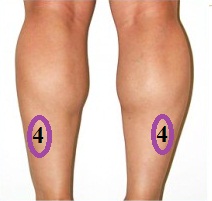Big toe (hallux) pain occurs in a significant number of people at some point in their lives. Not only affecting athletes, hallux pain also includes the sedentary population to a significant degree. Early assessment and treatment of big toe pain is important in preventing long-term damage and chronic reinjury.
Although hallux pain triggers are various, this article will be focused on pain due to stress and strain on the joint due to the surrounding musculature. If hallux pain is mainly located on the plantar (bottom) side of the foot, the four points found here may help provide significant relief. These simple points can be manipulated oneself or treated by a skilled massage therapist or licensed acupuncturist.
Point 1 – Abductor hallucis muscle. This muscle is responsible for plantar flexion of the hallux and some medial deviation (hallux varus) of the proximal phalanx (big toe points away from other toes). The abductor hallucis gives structure to the medial arch of the foot as well. Tight abductor hallucis muscles can be easily mistaken for plantar fasciitis pain. A notable distinction is that this pain is typically concentrated along the medial arch of the foot between the 1st metatarsophalangeal joint and the calcaneous (heel). [See Figure 1 for treatment location.]
Point 2 – Adductor hallucis muscle. Compared to abductor hallucis, this muscle similarly plantar flexes the big toe, but laterally deviates (hallux valgus) the proximal phalanx (big toe points toward other toes). The opposing forces of the adductor hallucis and abductor hallucis provide stabilization of the hallux in the transverse plane. Severe lateral deviation of the proximal phalanx is sometimes referred to as a bunion. The adductor hallucis pain is typically concentrated on the lateral edge of the 1st metatarsophalangeal joint and can spread to an area beneath the 2nd through 5th metatasophalangeal joints. This muscle is considered a deep foot muscle and will require adequate pressure for stimulation. [See Figure 1 for treatment location.]
Point 3 – Flexor Hallucis Brevis muscle. The flexor hallucis brevis shares some of the function of both the abductor and adductor hallucis muscles. Pain caused by the flexor hallucis brevis is mainly located around the 1st metatarsophalangeal joint. This muscle is considered a deep foot muscle and will require adequate pressure for stimulation. [See Figure 1 for treatment location.]
Point 4 – Flexor Hallucis Longus muscle. This muscle is located outside the foot and is thus known as an extrinsic foot muscle. It resides in the lower leg behind the soleus muscle and attaches to the fibula. The flexor hallucis longus is a comparably large plantar flexor of the hallux and is thus responsible for strong plantar flexion of the big toe, especially during walking and running. This muscle is one of the most important muscles to treat in big toe pain and due to its remote location, one of the least addressed. Since this muscle is deep to the soleus, adequate pressure is necessary for proper treatment of the flexor hallucis longus. [See Figure 2 for treatment location.]
In any painful foot condition, treat the musculature and soft tissue first. Tight muscles will continuously pull on joints and elicit pain. This common occurrance is often overlooked in sourcing joint pain. Intolerance to orthotics may be a sign that the muscles in the foot are causing pain or problems associated with the big toe and foot. Before seeking out orthotics, one should have the surrounding musculature checked for tender trigger points and sensitivity. Orthotics typically solve structural problems of the foot and should not be used until all of the functional components (i.e. muscles, tendons, fascia) have been treated for some length of time. Calf cramps, foot cramps, poor circulation in the lower extremities are other signs that muscular problems in the feet are occuring. This functional approach to medicine can save hundreds to thousands of dollars in expenses and can circumvent more invasive procedures, such as surgery.
A simple, effective tool in maintaining the functional ability of the hallux is a rubber ball. Roll each foot over a ball for 5 minutes a day, spending a minute or more on each of the points listed above. Sit on the floor with legs straight out and place the ball under #4. The weight of the lower leg may provide enough pressure to stimulate the flexor hallucis longus. If not, cross the other leg over top of the leg being treated to increase the weight. This procedure should be followed 4-5 days a week for a couple of months to allow the muscle spasms and tightness to abate. This is an excellent way to promote good blood circulation, massage intrinsic foot muscles, stimulate nerve endings, and refresh tired, worn out feet.
August Point Wellness offers a self-massage tool called the Sciaticare Ball that is quite a bit more useful than the rubber ball stated previously. The Sciaticare Ball can be used on feet, calves, back, hips, and much more. With an easy to place handle, it allows better control in massaging those hard to reach places. Visit www.augustpoint.com or Amazon to purchase. As always, for best results, seek out the guidance of a licensed massage therapist or acupuncturist and combine professional treatment with self-treatment for optimal health.
Related links:


